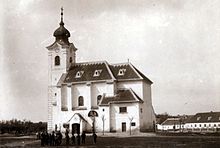Parish church Roseldorf
The parish church Roseldorf Mariae Birth is an east-facing Roman Catholic church with a west tower in Roseldorf , a cadastral parish of Sitzendorf an der Schmida in Lower Austria . It stands in the north-western part of the Angers.
The parish is located in the Hollabrunn deanery in the Vicariate Unter dem Manhartsberg belonging to the Archdiocese of Vienna .
history
Parish history
Nothing is known about when the parish was founded. From 1269 to 1564, Roseldorf was a branch church of the Gars-Eggenburg parish before it became an independent parish under the patronage of the sovereign . During the Reformation the parish fell completely, so in 1638 the parsonage was described as completely ruined . After the Counter Reformation was over, Roseldorf was united with the parish of Braunsdorf between 1621 and 1677.
Building history
In 1269 a church in Roseldorf was mentioned for the first time when reports of a new church were built. Nothing is known about the previous building and the circumstances that led to its destruction. The new building must have been completed in 1280 because the Bishop of Passau was asked to consecrate the church in that year .
Nothing of this building has survived either, and it is also not known whether extensions have taken place or whether a new building has been built.
After 1677 a new church was built, of which only a few baroque parts have been preserved.
Building description
Outside
The four-storey tower with cordon ribbons and onion helmet , drawn in to the north, comes from the previous building from the time before 1677. It has arched windows in the sound floor and clock gable. The onion helmet is crowned by a tower ball with a trefoil cross .
The nave was rebuilt between 1964 and 1966 according to plans by Erwin Plevan and consecrated in the year of completion . It has a steep, sloping hipped roof with large dormer windows . The iron construction of the open roof structure with wooden cladding rests on concrete-supported window walls in the north and south and on a portico in the east .
Inside
From the previous building from the time before 1677, the square cross - ridge -vaulted choir yoke and the semicircular triumphal arch with bandwork in the east have been preserved.
To the left of the triumphal arch is the access to a small north chapel with a doorframe of the previous building. The modern tabernacle is integrated into the baroque masonry of the triumphal arch in the lower part on the right side .
The two side walls of the nave are designed as window walls. To the east is the gallery with direct access from the nave.
Furnishing
About the people's altar , the top image of the former depends high altar with the motif of the Holy Trinity dating back to the turn of the century from the 17th and 18th centuries. Below is a glass shrine with the grace figure "Maria Tasch" from the 19th century. The shrine is flanked by two angel figures on cloud banks that come from the former high altar. Baroque statues of Saints Florian and Leopold from the end of the 17th century stand next to the popular altar .
In front of the tabernacle set into the masonry of the triumphal arch on the right side is part of the baroque communion bench made of sandstone. To the right of it is a hunched baroque baptismal font from the end of the 17th century.
The rest of the furnishings and the stained glass on the window walls by Franz Deéd date from the time the nave was built.
organ
The Rieger Orgelbau company manufactured the instrument in 1915 for the chapel of the Rudolfspital in Vienna . In 1967 it was transferred to Roseldorf, where the organ was installed in the parish church on June 25th. The organ on the west gallery is elevated on a stage. The lower case takes up the entire width of the instrument and is divided into four fields by strips, which are closed at the top by a continuous cornice. The upper part of the broad prospectus is dominated by three pipe fields, which are connected by a framing acanthus wreath. There are 23 pipes in the large middle field and eleven pipes in each of the two flanking outer fields. The case is crowned by curved cornices and cornices in the Rococo style and a small radiant cross in the middle. The organ has 20 registers , divided into two manuals and pedal , with the following disposition :
|
|
|
||||||||||||||||||||||||||||||||||||||||||||
-
Pairing :
- Normal coupling: II / I, I / II, I / P, P / I, II / P
- Super octave coupling: Sub II / I
- Sub-octave coupling: Super II / I, Super II / II, Super I / P, Super II / P
- Playing aids : Fixed combinations (p, mf, f, tutti, trigger), free combination, principal choir, gamba choir, flute choir, trigger
Bell jar
The bell from 1783 was made by Johann Georg Fielgrader from Vienna.
literature
- Dehio manual. The art monuments of Austria. Lower Austria north of the Danube. Edited by Evelyn Benesch, Bernd Euler-Rolle u. a. Verlag Anton Schroll & Co, Vienna 1990, ISBN 3-7031-0652-2 , p. 994 f.
- Peter Aichinger-Rosenberger (Ed.): At home in Sitzendorf - home book of the market town Sitzendorf an der Schmida . Sitzendorf an der Schmida, 2006, ISBN 3-200-00577-7 , p. 555 ff.
Web links
Individual evidence
Coordinates: 48 ° 38 ′ 46 ″ N , 15 ° 55 ′ 41 ″ E



